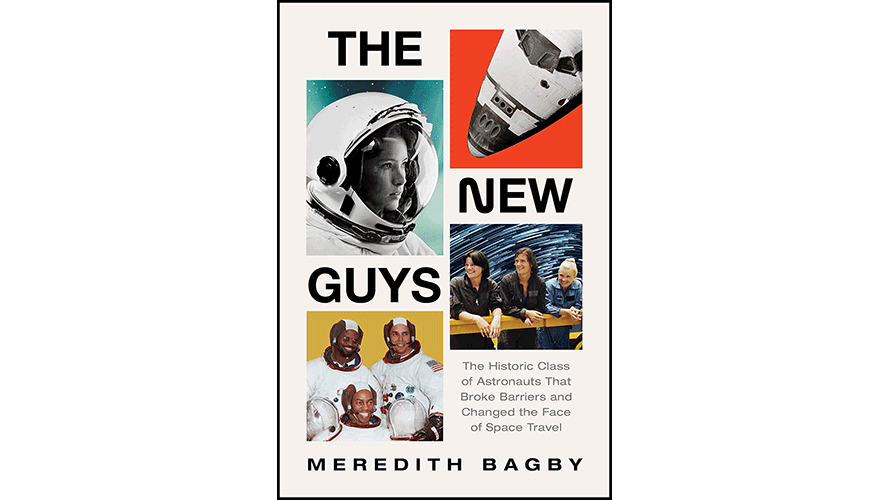Category: Nonfiction
Reviewed by: Douglas G. Adler
Title: The New Guys: The Historic Class of Astronauts That Broke Barriers and Changed the Face of Space Travel
Author: Meredith Bagby
NSS Amazon link for this book
Format: Hardcover/Kindle
Pages: 529
Publisher: William Morrow
Date: February 2023
Retail Price: $40.00/$15.99
ISBN: 978-0063141971
In the wake of the Civil Rights movement of the 1960s, the United States Congress passed the Equal Employment Opportunity Act of 1972. NASA, looking to diversify the Astronaut Corps, and recognizing that they needed a lot of new astronauts to fly the upcoming Space Shuttle missions, selected Astronaut Group 8. Astronaut Group 8 was notable for the inclusion of six women, one of whom was Jewish, three Astronauts who were Black, and one who was Asian.
“The New Guys” ostensibly sets out to chronicle the experiences of the women and minority members of Astronaut Group 8, but actually accomplishes a much larger goal along the way: giving the reader a boots-on-the-ground view, and oral history of, the Space Shuttle program from the 1970s through its end in 2011. Much of the book, as you would expect, details the trials and tribulations of this diverse group entering the formerly all-white, and all-male, world of NASA astronauts. NASA, as it turns out, is actually a pretty welcoming place and most of the members of Astronaut Group 8 went on to have extremely impressive careers with the organization, including both notable spaceflights and positions in upper management.
Sally Ride, the first American woman in space, is the de-facto centerpiece of the book, and much of NASA and the Space Shuttle program is viewed through Ride’s eyes. Ride’s selection, training, and flights are discussed in detail, as are the roles she played in the investigations into the loss of the Space Shuttles Challenger and Columbia. Ride’s sexuality is also discussed in detail (her 2012 obituary revealed to the world that she was a lesbian).
Ride’s classmate Judy Resnik (a Jewish woman) is also covered extensively. Resnik wanted to be an astronaut so badly she hunted down Apollo 11 Command Module Pilot Michael Collins at the National Air and Space Museum in Washington, DC, where he was curator, to pick his brain and find out how to achieve her goal. Resnik would perish in January of 1986 during the Challenger Disaster.
Other notables in this astronaut class include: Shannon Lucid, who famously spent 188 days aboard the Mir Space Station and flew on the Space Shuttle six times; Ron McNair, an African-American who also perished alongside Resnik; Ellison Onizuka (an Asian astronaut and another casualty of the Challenger Disaster); Jeffrey Hoffman, who was also Jewish and flew aboard the shuttle five times; and Rhea Sheldon, who flew aboard the Space Shuttle three times.
The book’s most interesting sections cover the Challenger Disaster in great detail. There is little new factual information presented here per se, but the story of the accident, the investigation, and the recovery of the crew from the ocean floor are presented in very personal and emotional terms. The crew of the Challenger included four members of Astronaut Group 8, so the events are recalled and described by people who knew these individuals very closely and were their friends and colleagues. Most books that detail the disaster focus on the technical aspects of the event (O-Rings, solid rocket booster field joints, the discussions at Morton Thiokol on the eve of the launch, etc.) whereas this book details the toll the accident had on the NASA administration, the investigators, the crew’s families and the other astronauts.
Overall, this is a well-written and interesting work that provides a lot of appealing and relatable personal anecdotes about life (and death) at NASA, astronaut selection, and the Space Shuttle program. The book is on the long side and the brisk pace of the early chapters slows as the reader wends their way through the decades. I suspect the book could have been shortened by 50-100 pages without significant loss to the reader. By the end of the book, there is a tone of finality and “wrapping things up.” NASA was shifting its focus to the International Space Station, and many of the Group 8 Astronaut class had left NASA or retired by then, so there is simply less story for Bagby to tell. This book would be best recommended to those with interest in becoming astronauts themselves or anyone with a deep and abiding interest in the Space Shuttle years at NASA.
© 2023 Douglas G. Adler
Please use the NSS Amazon Link for all your book and other purchases. It helps NSS and does not cost you a cent! Bookmark this link for ALL your Amazon shopping!



















